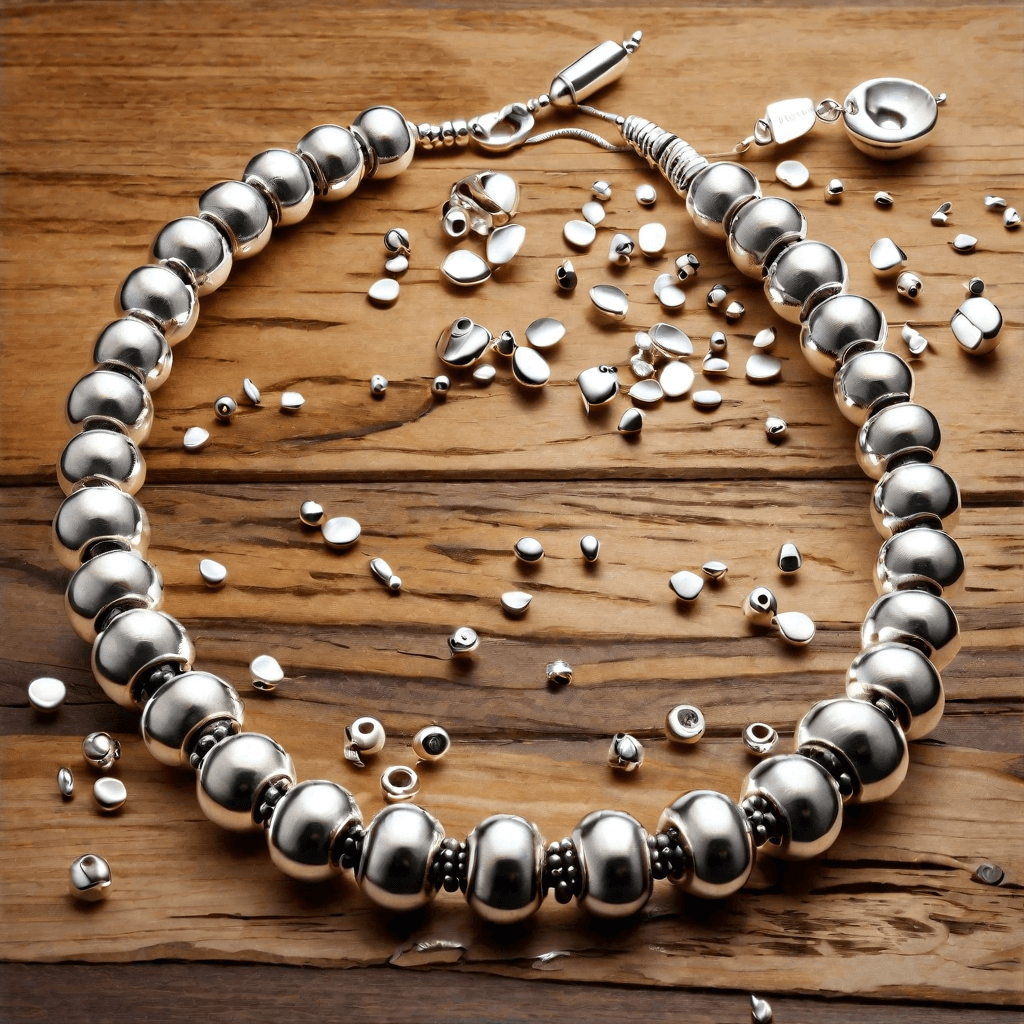Jewelry making is a timeless and rewarding craft, allowing artisans to express their creativity through unique and personalized pieces. Sterling silver beads, known for their lustrous appearance and durability, have become popular among jewelry makers. This comprehensive guide provides valuable insights and tips for working with sterling silver beads, ensuring that your jewelry creations shine with elegance and quality.
Table of Contents
Tools and Materials
Essential Jewelry Making Tools:
Round-nose pliers
Chain-nose pliers
Flush cutters
Crimping tool
Beading mat
Sterling Silver Beads:
Choose from various shapes, such as round, oval, cube, or bicone beads.
Consider different finishes like polished, oxidized, or brushed for added texture for your sterling silver beads for jewelry making.
Stringing Materials:
High-quality beading wire
Silk or nylon thread for delicate projects
Elastic cord for stretch bracelets
Findings:
Sterling silver clasps, jump rings, and crimp beads
Headpins and eye pins for creating dangles
Design Considerations
Color Coordination
In the intricate world of jewelry design, color coordination stands as a cornerstone, influencing your creations’ visual impact and overall aesthetic. The potential for dynamic color combinations is expansive when working with sterling silver beads. It is essential to deliberate upon the overall color scheme of your design, as sterling silver acts as a chameleon, seamlessly harmonizing with various gemstones and beads. Whether you opt for the classic elegance of monochromatic tones or experiment with bold and contrasting hues, the versatility of sterling silver ensures that your jewelry resonates with individuality and sophistication.
Texture and Finish
The texture and finish of sterling silver beads are pivotal in infusing character and visual intrigue into your jewelry pieces. This facet of design invites you to embark on an exploration of artistic possibilities. Experimentation is vital as you navigate through an array of textures, from the sleek and lustrous polish of beads to the earthy, time-worn allure of oxidized finishes. Combining both polished and oxidized sterling silver beads within a single design introduces a captivating interplay of light and shadow, resulting in a distinctive contrast that adds depth and complexity to your creations. The tactile experience becomes just as significant as the visual, making your jewelry a feast for the eyes and a delight to touch.
Balance and Proportion
Achieving a sense of equilibrium and proportion is fundamental to creating visually appealing and well-balanced jewelry pieces. As you embark on the design journey with sterling silver beads, consider the interplay between different bead sizes and shapes. Paying meticulous attention to balance ensures that your jewelry exudes a harmonious aesthetic, capturing the eye without overwhelming the senses. Mixing varying sizes, whether it be tiny delicate beads with larger focal ones, adds a sense of rhythm to your designs. Moreover, juxtaposing different shapes, such as rounds, ovals, cubes, or bicones, provides an opportunity for creative expression and ensures a captivating interplay within the overall composition. Striking the perfect balance and proportion in your designs enhances the visual appeal and contributes to the comfort and wearability of your sterling silver bead jewelry.
Techniques for Working with Sterling Silver Beads
Stringing
In the intricate art of jewelry making, the method of stringing plays a pivotal role in determining the structural integrity, flexibility, and drape of the final piece. Opting for beading wire is a strategic choice, ensuring a delicate balance between durability and flexibility. Beading wire, composed of multiple strands of stainless steel or nylon coated with a thin layer of nylon, provides the necessary strength to support the weight of beads while offering the flexibility required for comfortable wear. This essential component is the backbone of your design, allowing for fluid movement and enhancing the overall longevity of your sterling silver bead jewelry.
Ensuring the longevity of your creation goes beyond the initial stringing process. Properly crimping the wire is crucial in securing the beads in place. Utilizing crimp beads and a crimping tool ensures a secure and tidy finish. The crimping process not only fortifies the connection but also contributes to the aesthetic cohesion of your design. This attention to detail ensures that your sterling silver bead jewelry not only dazzles with visual appeal but also withstands the test of time, promising a lasting and cherished accessory.
Wire Wrapping
Wire wrapping is a versatile and artistic technique that empowers jewelry makers to elevate their designs by adding loops for attaching beads or creating delightful dangles. Learning basic wire wrapping techniques opens up possibilities for personalizing your sterling silver bead creations. Whether you create intricate loops for connecting beads seamlessly or playful dangles that sway with movement, wire wrapping allows you to infuse your designs with a distinctive and personalized touch. Mastery of this technique adds dimension to your jewelry and showcases your craftsmanship, turning each piece into a wearable work of art.
Knotting
Knotting emerges as a timeless and elegant technique in jewelry, especially when working with pearls or other delicate gemstones. Knotting between beads imparts a classic aesthetic and serves a functional purpose. By adding knots between each bead, you create intervals that protect the gems from rubbing against each other, reducing the risk of damage and preserving the piece’s integrity. Knotting, often executed with silk or nylon thread, introduces sophistication to your sterling silver bead jewelry, transforming each creation into a symbol of refined craftsmanship and enduring beauty.
Finishing Touches
In the meticulous world of jewelry making, the importance of finishing touches cannot be overstated. Sterling silver findings, the essential components that complete your jewelry piece, ensure a cohesive and high-quality finish. From clasps that secure your necklace or bracelet to jump rings that connect various elements seamlessly, each finding contributes to your creation’s overall functionality and aesthetic unity. Opting for sterling silver findings elevates your jewelry’s visual appeal and enhances its perceived value. By selecting findings crafted from the same material as your beads, you create a harmonious composition that speaks to the meticulous attention you devote to every aspect of your sterling silver bead jewelry.
Care and Maintenance
Avoid Exposure to Harsh Chemicals
Remove your sterling silver jewelry before swimming or using household cleaning products to prevent tarnishing.
Storage
Store your jewelry in a cool, dry place, preferably in a tarnish-resistant box or pouch.
Polishing
Regularly polish your sterling silver jewelry with a soft cloth to maintain its shine. Use a silver polishing cloth for intricate designs.
Advanced Techniques and Tips
Soldering
For advanced jewelry makers, soldering provides a way to connect sterling silver components seamlessly. Mastering soldering techniques allows you to create intricate and custom-designed jewelry pieces.
Patina and Oxidation
Experiment with patina solutions to enhance the appearance of your sterling silver beads. Oxidation can add depth and character to your designs, giving them a vintage or rustic feel.
Incorporating Gemstones
Combine sterling silver beads with gemstones to add color and vibrancy to your designs. Be mindful of the gemstone’s hardness and durability to ensure longevity.
Mixed Media
Explore mixed media by incorporating materials like leather, silk, or even alternative metals to create unique and eclectic jewelry pieces.
Customization
Consider customizing sterling silver beads by engraving, stamping, or hammering to add a personal touch to your creations.
Troubleshooting Tarnish and Cleaning Techniques
Tarnish Prevention
Minimize tarnish by storing your jewelry in anti-tarnish pouches or using anti-tarnish strips in storage containers.
Cleaning Solutions
Create a gentle cleaning solution by mixing mild soap with warm water. Use a soft brush to clean intricate designs, and pat dry with a clean cloth.
Commercial Cleaners
Invest in commercially available silver cleaners or polishing creams. Follow the product instructions carefully to avoid damaging your sterling silver beads.
Sustainable Practices in Jewelry Making
Recycled Sterling Silver
Use recycled sterling silver beads to reduce environmental impact and support sustainable jewelry-making practices.
Upcycling
Repurpose old or broken jewelry components to create new and unique designs. Upcycling reduces waste and adds a sentimental element to your creations.
Environmentally Friendly Packaging
Use eco-friendly packaging materials to minimize your carbon footprint. Consider recycled paper or reusable fabric pouches for packaging your jewelry.
Connecting with the Community
Joining Jewelry-Making Groups
Connect with fellow jewelry makers through online forums, social media groups, or local workshops. Sharing experiences and learning from others can enhance your skills and inspire new ideas.
Attending Craft Shows and Markets
Showcase and sell your sterling silver bead creations at craft shows or local markets to gain exposure and receive feedback from potential customers.
Staying Inspired and Evolving as an Artisan
Continuous Learning
Stay updated on the latest trends, techniques, and jewelry-making tools. Attend workshops, read books, and follow reputable online resources to expand your knowledge and stay inspired.
Experimentation
Embrace a spirit of experimentation by trying new techniques, combining different materials, and pushing the boundaries of your creativity. Sometimes, the most innovative designs come from stepping outside your comfort zone.
Sketching and Designing
Keep a sketchbook to jot down design ideas, sketch rough concepts, and plan your projects. This visual aid can be a roadmap for turning your creative visions into tangible, wearable pieces.
Seeking Feedback
Share your work-in-progress or finished pieces with trusted friends, fellow artisans, or mentors. Constructive feedback can provide valuable insights and help refine your skills.
Marketing Your Creations
Photography
Invest time in capturing high-quality images of your jewelry. Good photography can significantly enhance your online presence and attract potential customers.
Building an Online Presence
Create a professional website or utilize online marketplaces to showcase and sell sterling silver bead jewelry. Utilize social media platforms to connect with your audience, share your creative process, and engage with the jewelry-making community.
Crafting a Unique Brand Story
Develop a compelling narrative behind your brand. Share the inspiration, craftsmanship, and personal touch in each piece. A compelling story can resonate with customers and create a deeper connection to your creations.
Networking
Attend industry events, collaborate with other artisans, and participate in local markets to network with potential customers and fellow jewelry makers. Building relationships within the jewelry-making community can open new opportunities and collaborations.
Adapting to Trends and Customer Preferences
Market Research
Stay informed about evolving trends in the jewelry industry. Understanding market preferences allows you to tailor your designs to meet customer expectations and stay ahead of the curve.
Customization Services
Offer customization options to cater to individual tastes and preferences. Providing personalized jewelry adds a unique touch and increases customer satisfaction.
Quality Assurance
Prioritize quality in your craftsmanship. Consistently delivering high-quality sterling silver bead jewelry establishes customer trust and encourages repeat business.
Conclusion
Working with sterling silver beads is not just a craft; it’s an art form that allows you to create timeless pieces of beauty and expression. You can leave a lasting legacy as an artisan by understanding the intricacies of sterling silver, mastering techniques, staying inspired, and adapting to the ever-changing landscape of jewelry making.














